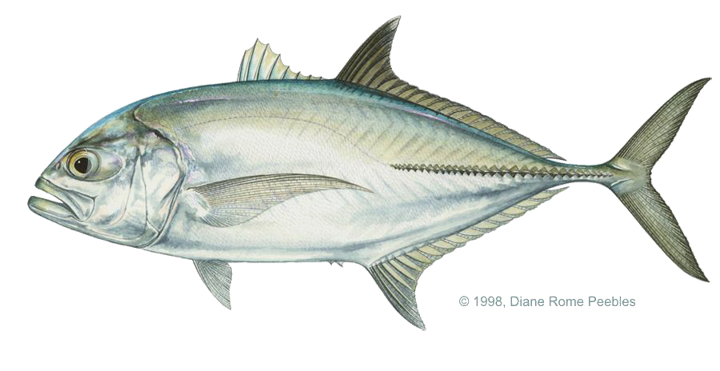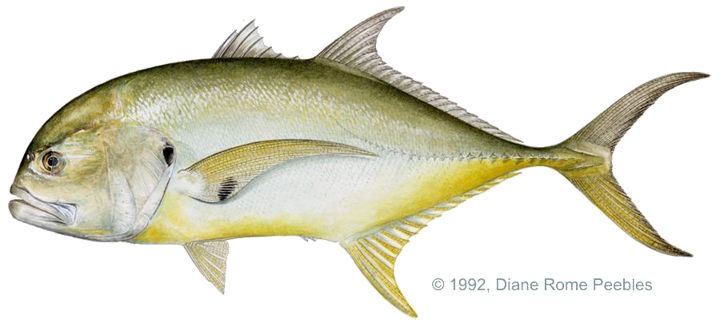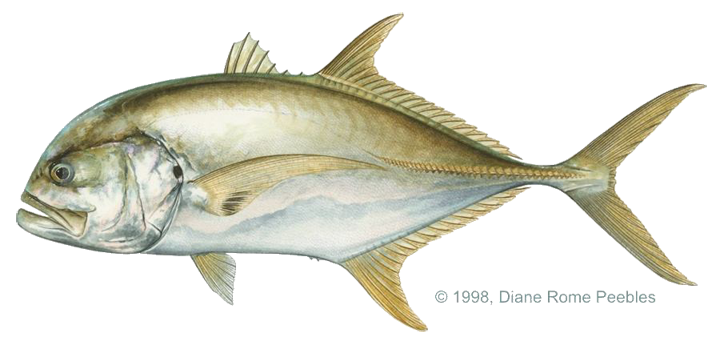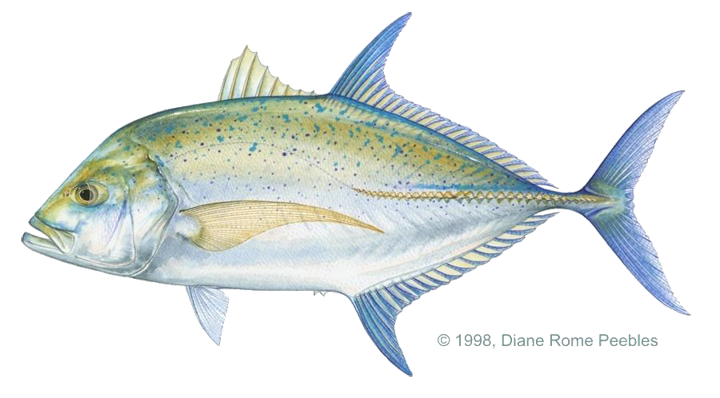Game Fish Identification Reference Guides
Trevally, bigeye
(Caranx sexfasciatus)
(Caranx sexfasciatus)

Quoy & Gaimard, 1825; CARANGIDAE FAMILY; also called turrum, ulua, previously known by the misnomers giant or great trevally
Broadly found in tropical waters throughout the Indian and Pacific Oceans from east Africa to western America. It is found in rocky areas near shore as well as at outside reef drop offs on the edge of deep tide running channels, and in the deeper waters beyond the reef. This species is replaced in the Atlantic Ocean by its close relative the horse eye jack (Caranx latus).
The maximum verified size is 30 in (757 mm) fork length. The breast is completely scaled. The body is not very deep (more elongated) with the head curved to a slightly pointed snout. The eyes are relatively large. The lateral line is strongly curved anteriorly. The straight portion consists of 28 37 scutes. The first dorsal fin has 8 spines (rarely 7). The second has 1 spine and 19 22 soft rays and the anal fin has 3 spines (2 are detached) and 15 17 soft rays. There is a total of 20 25 gill rakers on the first branchial arch. There is a pair of lateral keels on either side of the caudal peduncle. Body color ranges from silvery to dusky or dark, especially along the back. The dorsal fin lobe is dark with a white tip and the scutes are usually black. There is a dark spot on the gill cover, but none on the pectoral fins. Juveniles are golden yellow and have 4 7 broad, dark vertical bars on the body.
Adults feed most actively at night, especially very dark nights. Diet includes eels and crustaceans, blennies (pao'o), damselfish (mamo), and other fishes. Fishing methods include trolling baits and lures, angling with live or cut baits while drifting or at anchor, and surf fishing. Trolled lure or bait should be moved slowly among other bait fish or along the outside drop offs of reefs or rocky ledges. Mullet, herring, sauri, garfish, anchovy, squid, or strip baits are used as well as Konaheads, knuckleheads, bulletheads, feathers, plastic jigs, plastic fish and squid, drone spoons and rope lures.
The flesh is pinkish and is rated fair in taste and quality. In some areas of the Pacific, it is highly esteemed as food. It is also frequently used for strip baits, cut baits, or as chum
Broadly found in tropical waters throughout the Indian and Pacific Oceans from east Africa to western America. It is found in rocky areas near shore as well as at outside reef drop offs on the edge of deep tide running channels, and in the deeper waters beyond the reef. This species is replaced in the Atlantic Ocean by its close relative the horse eye jack (Caranx latus).
The maximum verified size is 30 in (757 mm) fork length. The breast is completely scaled. The body is not very deep (more elongated) with the head curved to a slightly pointed snout. The eyes are relatively large. The lateral line is strongly curved anteriorly. The straight portion consists of 28 37 scutes. The first dorsal fin has 8 spines (rarely 7). The second has 1 spine and 19 22 soft rays and the anal fin has 3 spines (2 are detached) and 15 17 soft rays. There is a total of 20 25 gill rakers on the first branchial arch. There is a pair of lateral keels on either side of the caudal peduncle. Body color ranges from silvery to dusky or dark, especially along the back. The dorsal fin lobe is dark with a white tip and the scutes are usually black. There is a dark spot on the gill cover, but none on the pectoral fins. Juveniles are golden yellow and have 4 7 broad, dark vertical bars on the body.
Adults feed most actively at night, especially very dark nights. Diet includes eels and crustaceans, blennies (pao'o), damselfish (mamo), and other fishes. Fishing methods include trolling baits and lures, angling with live or cut baits while drifting or at anchor, and surf fishing. Trolled lure or bait should be moved slowly among other bait fish or along the outside drop offs of reefs or rocky ledges. Mullet, herring, sauri, garfish, anchovy, squid, or strip baits are used as well as Konaheads, knuckleheads, bulletheads, feathers, plastic jigs, plastic fish and squid, drone spoons and rope lures.
The flesh is pinkish and is rated fair in taste and quality. In some areas of the Pacific, it is highly esteemed as food. It is also frequently used for strip baits, cut baits, or as chum

















